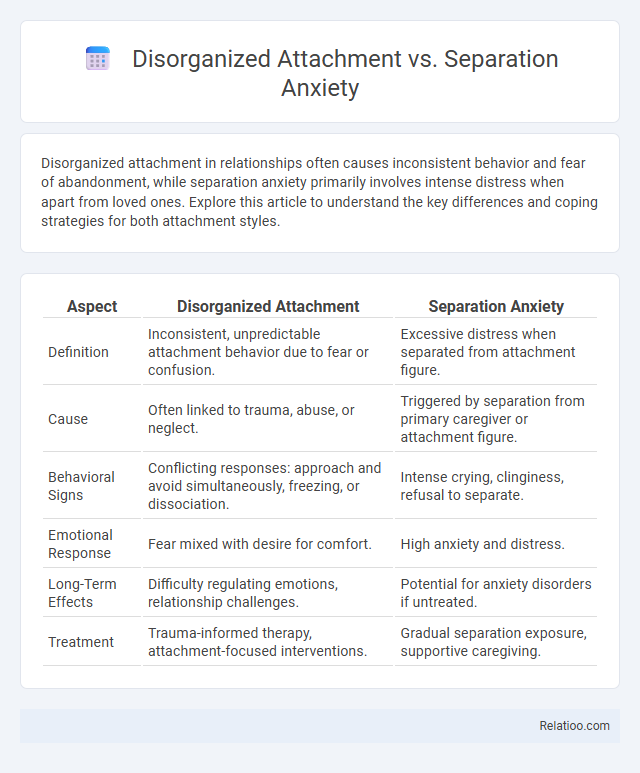Disorganized attachment in relationships often causes inconsistent behavior and fear of abandonment, while separation anxiety primarily involves intense distress when apart from loved ones. Explore this article to understand the key differences and coping strategies for both attachment styles.
Table of Comparison
| Aspect | Disorganized Attachment | Separation Anxiety |
|---|---|---|
| Definition | Inconsistent, unpredictable attachment behavior due to fear or confusion. | Excessive distress when separated from attachment figure. |
| Cause | Often linked to trauma, abuse, or neglect. | Triggered by separation from primary caregiver or attachment figure. |
| Behavioral Signs | Conflicting responses: approach and avoid simultaneously, freezing, or dissociation. | Intense crying, clinginess, refusal to separate. |
| Emotional Response | Fear mixed with desire for comfort. | High anxiety and distress. |
| Long-Term Effects | Difficulty regulating emotions, relationship challenges. | Potential for anxiety disorders if untreated. |
| Treatment | Trauma-informed therapy, attachment-focused interventions. | Gradual separation exposure, supportive caregiving. |
Understanding Disorganized Attachment
Disorganized attachment emerges from inconsistent caregiver responses, leading to confusion and fear in Your child's emotional framework, unlike separation anxiety which primarily involves distress over caregiver absence. Separation anxiety represents a normative developmental phase characterized by distress during temporary separation, whereas disorganized attachment reflects deeper relational trauma resulting in unpredictable behavior patterns. Understanding disorganized attachment is crucial for addressing Your child's complex emotional needs and promoting secure relational bonds.
What is Separation Anxiety?
Separation anxiety is a developmental condition characterized by excessive fear or distress when separated from primary caregivers, typically emerging in early childhood but potentially persisting into adulthood. Different from disorganized attachment, which involves inconsistent caregiver responses leading to confusion and fear, separation anxiety specifically centers on the emotional difficulty and worry experienced during physical or perceived separation. Understanding separation anxiety involves recognizing symptoms such as clinginess, tantrums, and somatic complaints that disrupt social and academic functioning.
Key Differences Between Disorganized Attachment and Separation Anxiety
Disorganized attachment is characterized by contradictory behaviors and confusion in relationships due to inconsistent caregiving, leading to impaired emotional regulation, while separation anxiety involves excessive fear or distress when separated from attachment figures, often manifesting in childhood with symptoms like crying and clinging. Unlike separation anxiety, which is a specific emotional response, disorganized attachment reflects a deep-rooted relational pattern affecting overall attachment security and social development. The key difference lies in disorganized attachment's impact on long-term relational strategies, whereas separation anxiety primarily centers on acute distress linked to separation events.
Signs and Symptoms of Disorganized Attachment
Disorganized attachment is characterized by contradictory behaviors such as approaching and avoiding a caregiver, confusion, and fear without soothing, often manifesting as freezing or dazed expressions. Unlike separation anxiety, which primarily features intense distress and clinginess when separated from a caregiver, disorganized attachment reflects inconsistent and unpredictable reactions to stress or comfort. Your awareness of these signs--such as difficulty trusting caregivers and displaying both seeking and rejecting comfort--can guide effective support and intervention strategies.
Manifestations of Separation Anxiety in Children
Separation anxiety in children often manifests through excessive fear or distress when away from primary caregivers, frequent tantrums, clinginess, and difficulty sleeping alone. Unlike disorganized attachment, which involves a lack of clear attachment behavior due to inconsistent caregiving, separation anxiety specifically centers on the emotional response triggered by separation. Your child's persistent worry about harm coming to caregivers or refusal to attend school can indicate problematic separation anxiety requiring supportive intervention.
Causes and Risk Factors for Disorganized Attachment
Disorganized attachment often arises from inconsistent caregiving, caregiver trauma, or abuse, which disrupts a child's ability to form secure emotional bonds. Separation anxiety typically stems from a child's fear of losing a primary caregiver, whereas disorganized attachment involves a profound internal conflict that can intensify this anxiety due to unpredictable responses from the caregiver. Your understanding of these causes and risk factors is essential for addressing these complex emotional challenges effectively.
Triggers of Separation Anxiety
Triggers of separation anxiety often include sudden or prolonged separation from primary caregivers, unfamiliar environments, or significant changes in routine that disrupt a child's sense of security. While disorganized attachment relates to inconsistent caregiver responses leading to confusion during separation, separation anxiety specifically manifests as intense distress when faced with actual or anticipated separation. Understanding these triggers helps you recognize early signs and provide reassurance to reduce the child's anxiety effectively.
Long-Term Effects: Disorganized Attachment vs Separation Anxiety
Disorganized attachment is linked to long-term emotional dysregulation, increased risk of mental health disorders, and difficulties in forming stable relationships. Separation anxiety, while often transient in childhood, can develop into chronic anxiety disorders impacting social functioning if untreated. The persistent effects of disorganized attachment generally pose greater challenges in emotional stability and interpersonal trust compared to separation anxiety.
Therapeutic Approaches and Interventions
Disorganized attachment often requires trauma-informed therapy such as EMDR or Dialectical Behavior Therapy to address underlying emotional dysregulation, while separation anxiety typically benefits from cognitive-behavioral interventions focusing on coping skills and gradual exposure to separation triggers. Therapeutic approaches for your child with separation anxiety might include family therapy to strengthen support systems and foster secure attachment patterns. Incorporating consistent routines and psychoeducation in therapy enhances emotional resilience and reduces the intensity of attachment-related distress.
Supporting Children: Practical Tips for Parents and Caregivers
Supporting children with disorganized attachment or separation anxiety requires consistent routines and emotional availability from parents and caregivers to foster a secure environment. Techniques such as reassuring physical comfort, validating feelings, and gradual exposure to separation can help children manage distress effectively. Engaging in open communication and seeking professional guidance when symptoms persist ensures tailored support for each child's unique emotional needs.

Infographic: Disorganized Attachment vs Separation Anxiety
 relatioo.com
relatioo.com